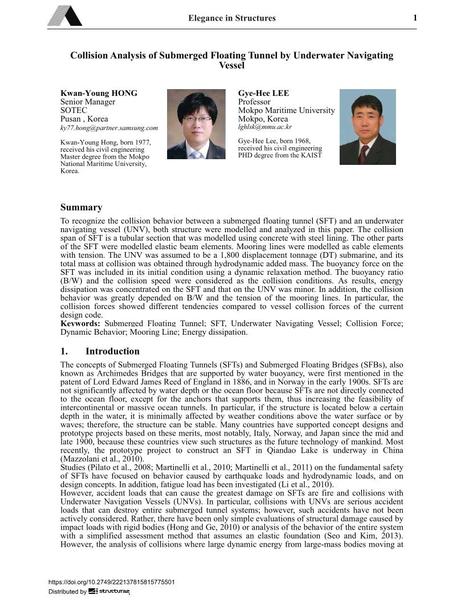Collision Analysis of Submerged Floating Tunnel by Underwater Navigating Vessel

|
|
|||||||||||
Bibliographic Details
| Author(s): |
Kwan-Young Hong
Gye-Hee Lee |
||||
|---|---|---|---|---|---|
| Medium: | conference paper | ||||
| Language(s): | English | ||||
| Conference: | IABSE Conference: Elegance in structures, Nara, Japan, 13-15 May 2015 | ||||
| Published in: | IABSE Conference Nara 2015 | ||||
|
|||||
| Page(s): | 386-387 | ||||
| Total no. of pages: | 8 | ||||
| Year: | 2015 | ||||
| DOI: | 10.2749/222137815815775501 | ||||
| Abstract: |
To recognize the collision behavior between a submerged floating tunnel (SFT) and an underwater navigating vessel (UNV), both structure were modelled and analyzed in this paper. The collision span of SFT is a tubular section that was modelled using concrete with steel lining. The other parts of the SFT were modelled elastic beam elements. Mooring lines were modelled as cable elements with tension. The UNV was assumed to be a 1,800 displacement tonnage (DT) submarine, and its total mass at collision was obtained through hydrodynamic added mass. The buoyancy force on the SFT was included in its initial condition using a dynamic relaxation method. The buoyancy ratio (B/W) and the collision speed were considered as the collision conditions. As results, energy dissipation was concentrated on the SFT and that on the UNV was minor. In addition, the collision behavior was greatly depended on B/W and the tension of the mooring lines. In particular, the collision forces showed different tendencies compared to vessel collision forces of the current design code. |
||||
| Keywords: |
dynamic behavior energy dissipation submerged floating tunnel SFT Underwater Navigating Vessel Collision Force Mooring Line
|
||||

